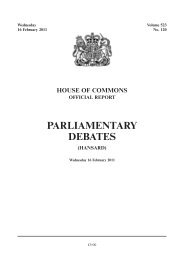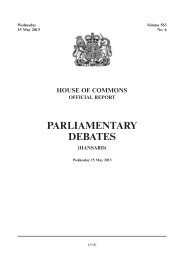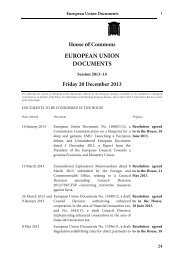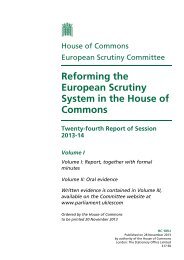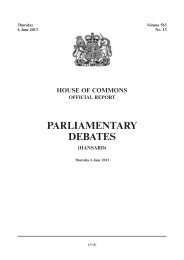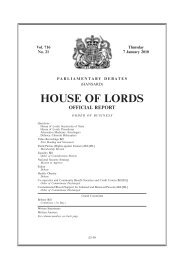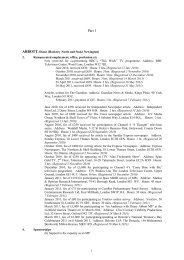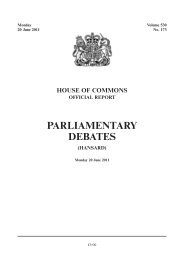Ticketing and Concessionary Travel on Public Transport - United ...
Ticketing and Concessionary Travel on Public Transport - United ...
Ticketing and Concessionary Travel on Public Transport - United ...
Create successful ePaper yourself
Turn your PDF publications into a flip-book with our unique Google optimized e-Paper software.
<strong>Transport</strong> Committee: Evidence Ev 97<br />
The gates used <strong>on</strong> the nati<strong>on</strong>al rail network, being based <strong>on</strong> those designed for the L<strong>on</strong>d<strong>on</strong> Underground,<br />
<strong>on</strong>ly work <strong>on</strong> the credit card size ticket, <str<strong>on</strong>g>and</str<strong>on</strong>g> can <strong>on</strong>ly check fairly basic informati<strong>on</strong> from the magnetic stripe.<br />
The <strong>on</strong>ly gate design for ATB format is that used by Eurostar, which have a quite diVerent functi<strong>on</strong> <str<strong>on</strong>g>and</str<strong>on</strong>g> are<br />
much slower, being linked to the train reservati<strong>on</strong> system so they are actually checking each train in. TOC<br />
gates cannot do that, so there is no prospect of doing a check at stati<strong>on</strong>s related to the train used.<br />
We now have Oyster cards in L<strong>on</strong>d<strong>on</strong> (<str<strong>on</strong>g>and</str<strong>on</strong>g> the ITSO problem), mobile ph<strong>on</strong>es (barcode scanner needed)<br />
<str<strong>on</strong>g>and</str<strong>on</strong>g> print-at-home (like ticketless airline travel bought via the internet) where 2D barcodes are used.<br />
Eurostar <str<strong>on</strong>g>and</str<strong>on</strong>g> European railways for Inter City travel are moving to the latter in place of the current ATB<br />
with magnetic stripe (coding is not just for reading by gates but is to protect against fraudulent ticket<br />
producti<strong>on</strong>).<br />
All this means that while ATB may wither away, other ticket types <str<strong>on</strong>g>and</str<strong>on</strong>g> media will come al<strong>on</strong>g that are<br />
not gate compatible, or even if they could be, there is a large system development task to get that to happen.<br />
With the multiplicity of uncoordinated gate installati<strong>on</strong>s <strong>on</strong> the TOCs over the past ten years, the evidence<br />
suggests that the integrati<strong>on</strong> of new ticket media, even if they are technically machine readable, will not<br />
easily be achieved.<br />
January 2008<br />
Memor<str<strong>on</strong>g>and</str<strong>on</strong>g>um from Mr Kevin Chapman (TPT 13)<br />
1. I write this submissi<strong>on</strong> as a public transport user in the West Midl<str<strong>on</strong>g>and</str<strong>on</strong>g>s c<strong>on</strong>urbati<strong>on</strong>, but I am also a<br />
supporter of the sustainable transport group <strong>Transport</strong> 2000. I do not drive <str<strong>on</strong>g>and</str<strong>on</strong>g> make the vast majority of<br />
journeys over a mile by bus <str<strong>on</strong>g>and</str<strong>on</strong>g>/or rail. It may be helpful for the committee to have comments regarding<br />
ticketing, revenue protecti<strong>on</strong> <str<strong>on</strong>g>and</str<strong>on</strong>g> c<strong>on</strong>cessi<strong>on</strong>ary fares within the West Midl<str<strong>on</strong>g>and</str<strong>on</strong>g>s.<br />
2. Multi-modal ticketing was introduced by the West Midl<str<strong>on</strong>g>and</str<strong>on</strong>g>s Passenger <strong>Transport</strong> Executive (now<br />
Centro) in the 1970’s, with the introducti<strong>on</strong> of “<str<strong>on</strong>g>Travel</str<strong>on</strong>g>card”, valid <strong>on</strong> bus services operated by WMPTE<br />
<str<strong>on</strong>g>and</str<strong>on</strong>g> the Nati<strong>on</strong>al Bus Company <str<strong>on</strong>g>and</str<strong>on</strong>g> local British Rail services within the West Midl<str<strong>on</strong>g>and</str<strong>on</strong>g>s County. WMPTE<br />
was am<strong>on</strong>gst the first transport organisati<strong>on</strong>s in the UK to introduced integrated ticketing, <str<strong>on</strong>g>and</str<strong>on</strong>g> over the<br />
years c<strong>on</strong>cessi<strong>on</strong>ary travel schemes for school children, students, the disabled <str<strong>on</strong>g>and</str<strong>on</strong>g> senior citizens have been<br />
included within the integrated ticketing scheme.<br />
3. Integrated ticketing in the West Midl<str<strong>on</strong>g>and</str<strong>on</strong>g>s County has survived deregulati<strong>on</strong> of bus services in 1986<br />
<str<strong>on</strong>g>and</str<strong>on</strong>g> privatisati<strong>on</strong> of the bus <str<strong>on</strong>g>and</str<strong>on</strong>g> rail industry in the 1990s, although a small number of bus operators do not<br />
participate in the scheme (although they do participate in the c<strong>on</strong>cessi<strong>on</strong>ary scheme). The scheme is now<br />
marketed by Centro under the “Network West Midl<str<strong>on</strong>g>and</str<strong>on</strong>g>s” banner. The products include an “nNetwork”<br />
ticket (valid <strong>on</strong> bus, rail <str<strong>on</strong>g>and</str<strong>on</strong>g> “Midl<str<strong>on</strong>g>and</str<strong>on</strong>g> Metro”), “nBus” (valid <strong>on</strong> buses) “nTrain” (valid <strong>on</strong> local rail<br />
services) <str<strong>on</strong>g>and</str<strong>on</strong>g> tickets aimed at the leisure market “nDaytripper”, valid at “oV-peak” times <str<strong>on</strong>g>and</str<strong>on</strong>g> an oV-peak<br />
versi<strong>on</strong> of the “nNetwork” ticket.<br />
4. The positi<strong>on</strong> within the West Midl<str<strong>on</strong>g>and</str<strong>on</strong>g>s County compares favourably with that outside of the county,<br />
within the Shire counties where no integrated tickets can be purchased. It is possible to buy an “nNetwork”<br />
ticket for an origin stati<strong>on</strong> outside of the West Midl<str<strong>on</strong>g>and</str<strong>on</strong>g>s county. This would allow the purchaser to use<br />
c<strong>on</strong>necting bus services within the West Midl<str<strong>on</strong>g>and</str<strong>on</strong>g>s County to complete their journey, but not a bus service<br />
to their origin stati<strong>on</strong>.<br />
5. The major bus operator in the West Midl<str<strong>on</strong>g>and</str<strong>on</strong>g>s County is <str<strong>on</strong>g>Travel</str<strong>on</strong>g> West Midl<str<strong>on</strong>g>and</str<strong>on</strong>g>s (the successor to the<br />
WMPTE bus operati<strong>on</strong>), who operate 95% of the commercial mileage. This is in c<strong>on</strong>trast to the positi<strong>on</strong> in<br />
other metropolitan areas where the PTE bus operati<strong>on</strong>s were split to enable competiti<strong>on</strong> (which has <strong>on</strong>ly<br />
happened <strong>on</strong> trunk corridors), but which has resulted in fragmentati<strong>on</strong> of a former unified network between<br />
two or three operators. Take up of pre-paid tickets has been much greater within the West Midl<str<strong>on</strong>g>and</str<strong>on</strong>g>s; the<br />
vast majority of tickets purchased being those designed <str<strong>on</strong>g>and</str<strong>on</strong>g> marketed by, <str<strong>on</strong>g>and</str<strong>on</strong>g> <strong>on</strong>ly valid <strong>on</strong>, <str<strong>on</strong>g>Travel</str<strong>on</strong>g> West<br />
Midl<str<strong>on</strong>g>and</str<strong>on</strong>g>s. The proporti<strong>on</strong> of passengers who pay their fare <strong>on</strong> the bus is much smaller within the West<br />
Midl<str<strong>on</strong>g>and</str<strong>on</strong>g>s than in other parts of the country.<br />
6. It is possible to buy some integrated tickets, such as a <strong>on</strong>e day versi<strong>on</strong> of the “nNetwork” ticket <strong>on</strong><br />
bus. As each of the bus operators use diVerent ticketing systems then a “nNetwork” ticket will look diVerent<br />
depending <strong>on</strong> what operators bus it is purchased <strong>on</strong>—<str<strong>on</strong>g>and</str<strong>on</strong>g> it will look similar to the operators own <strong>on</strong>e day<br />
ticket (valid <strong>on</strong> their services <strong>on</strong>ly). If the driver or inspector is not aware of the design of ticket then its<br />
validity could be questi<strong>on</strong>ed, even though it may be perfectly valid for use <strong>on</strong> the service c<strong>on</strong>cerned.<br />
7. The West Midl<str<strong>on</strong>g>and</str<strong>on</strong>g>s does participate in the “PlusBus” scheme, as do other areas in the country. From<br />
my travels around the country I would comment that promoti<strong>on</strong> <str<strong>on</strong>g>and</str<strong>on</strong>g> operati<strong>on</strong> of the “PlusBus” scheme is<br />
often poor—there is usually a map at the stati<strong>on</strong> showing the validity but there will be no sign <strong>on</strong><br />
participating bus saying that “PlusBus” tickets are accepted. (Indeed not all operators participate in<br />
“PlusBus”.) I often book train travel <strong>on</strong>-line, utilising TheTrainLine.com website. If you book your ticket<br />
via TheTrainline then at the time of writing you will not find reference to fares that include a “PlusBus”



